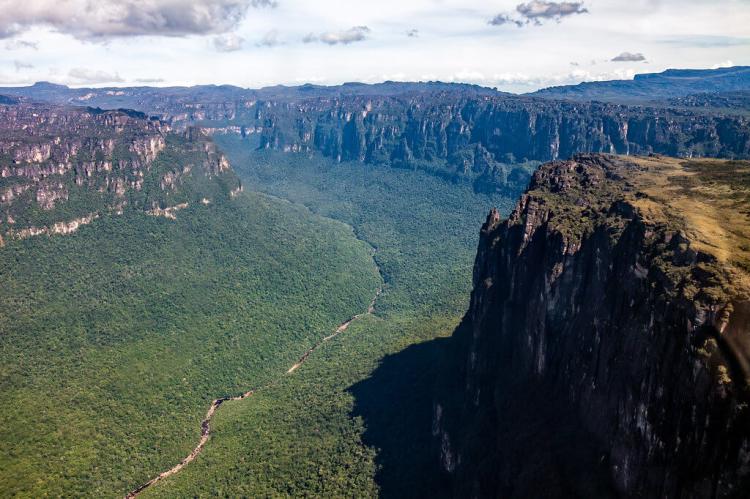The Mystical Pantepui: A Realm of Towering Tepuis and Exceptional Biodiversity
The Pantepui forests and shrublands ecoregion in the Guiana Highlands of South America is home to tabletop mountains called tepuis with isolated plateaus and summits on almost vertical escarpments. The area boasts ancient geological formations, stunning waterfalls, and diverse flora and fauna.
The Mystical Pantepui: A Realm of Towering Tepuis and Exceptional Biodiversity
The Pantepui forests and shrublands ecoregion is located in the Guiana Highlands of northern South America. This region is home to over 50 tabletop mountains, called tepuis, with isolated sandstone plateaus and summits on almost vertical escarpments. This area is truly remarkable, with ancient geological formations, stunning waterfalls, and diverse flora and fauna. It is a beautiful destination for those interested in exploring the world's natural wonders.
The Majestic Tepuis
Remnants of an Ancient Tableland
The tepuis, a word derived from the Pemón Amerindians, are the remnants of an ancient sandstone tableland overlying the even more ancient granitic Guiana Shield. These imposing mountains range from 1,000 to 3,000 meters (3,280 to 9,842 feet) in elevation, creating a striking contrast against the surrounding highland savannas and rainforests.
Dramatic Landscapes
The tepuis are characteristically flat-topped, with steep, nearly vertical escarpments interrupted by terraced talus slopes. Some mountains present undulating, irregular summit contours, each displaying its unique shape, biodiversity, and elevation characteristics. Standout features include the world's tallest uninterrupted waterfall, Angel Falls, plunging an astonishing 979 meters (3,212 feet) from the summit of Auyantepui.
Towering Giants
Among the highest peaks within the Pantepui ecoregion are Pico da Neblina in Brazil, soaring to 3,014 meters (9,888 feet), the adjacent Pico Phelps (2,992 meters or 9,816 feet) in Venezuela, the iconic Mount Roraima (2,810 meters or 9,219 feet), and Cerro Marahuaka (2,800 meters or 9,186 feet), both in Venezuela. Cerro Ichún, near the Brazil-Venezuela border, boasts the largest surface area of all the sandstone tabletop mountains, with a total area of 3,260 square kilometers (1,258 square miles) at an elevation of 1,400 meters (4,600 feet).
Climatic Conditions
The Pantepui forests and shrublands experience a constantly humid climate, receiving between 2,000 to 4,000 millimeters (78 to 157 inches) of rainfall annually, with a subtle dry season. Temperatures can drop to extremes of 0°C (32°F) on the highest summits, while generally ranging from 8°C to 20°C (46°F to 68°F) on average over the year, depending on elevation.
Biodiversity Hotspot
Unique Vegetation Zones
The vegetation on the tepuis is distinct from the surrounding Amazonian humid forests, forming a biogeographic complex. A representative tepui hosts four distinct vegetation zones, starting at the base, proceeding to the talus slope, then to the escarpment (cliff) base, and finally, the mountain summit. The summit vegetation is of particular interest, with a high rate of endemism (33%) and five distinct vegetation types, including forests, epiphytes, rock crevice dwellers, savannas, and exposed rock outcrops.
Mammalian Wonders
The Pantepui forests and shrublands ecoregion hosts an impressive 186 mammal species, mainly located on the lower slopes of the mountains. This diverse assemblage includes nine primates: howler monkeys, night monkeys, titi monkeys, black uakaris, weeper capuchins, and white-faced sakis. Five cat species, including jaguars and pumas, roam these lands. Endemic species found here include an opossum (Marmosa tyleriana), a white-eared opossum (Didelphis albiventris), long-tailed weasels, pale-throated sloths, and a variety of bats, rodents, and guinea pigs.
Avian Paradise
With 628 bird species, including 41 endemics, the Pantepui ecoregion is a true avian paradise. Unique species found here include tepui tinamous, fiery-shouldered parakeets, tepui parrotlets, roraiman nightjars, tepui swifts, rufous-breasted saber wings, buff-breasted saber wings, peacock coquettes, tepui golden throats, velvet-browed brilliants, white-throated foliage-gleaners, tepui antpittas, red-banded fruiteaters, and several manakin species.
Reptilian and Amphibian Diversity
The summits and slopes of the tepuis are teeming with reptiles and amphibians, including formidable snakes like the fer-de-lance, coral snakes, boa constrictors, and bushmasters. Iguanas and tegu lizards are also familiar sights in this ecoregion.
Conservation Efforts
Preserving a Natural Wonder
Due to the steep slopes and high summits of the Tepui mountains' inaccessibility, much of the natural habitat remains intact. To safeguard this ecological treasure, the mountains above 800 meters (2,600 feet) have been designated as protected conservation areas, including natural monuments, national parks, and biosphere reserves. Notable protected areas include Monte Roraima National Park in Brazil and Canaima National Park in Venezuela.
The Pantepui forests and shrublands ecoregion stands as a testament to nature's grandeur and resilience, where ancient geological formations, dramatic landscapes, and a remarkable diversity of life coexist. Continuing to unravel the secrets of this captivating ecoregion underscores the imperative to prioritize its conservation, ensuring that future generations can witness and appreciate the mystical beauty of the tepuis and their exceptional biodiversity.

Location map of the Pantepui forests and shrublands ecoregion (in purple).
